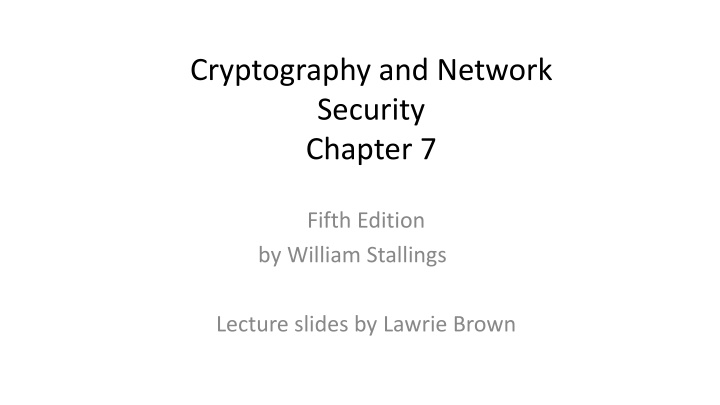
Stream Ciphers, Random Numbers, and RNG in Cryptography
Explore the importance of random numbers in cryptography, the use of stream ciphers, and the generation of true random and pseudorandom numbers. Learn about natural random noise sources, published sources, and the challenges of creating secure pseudorandom number generators.
Download Presentation

Please find below an Image/Link to download the presentation.
The content on the website is provided AS IS for your information and personal use only. It may not be sold, licensed, or shared on other websites without obtaining consent from the author. If you encounter any issues during the download, it is possible that the publisher has removed the file from their server.
You are allowed to download the files provided on this website for personal or commercial use, subject to the condition that they are used lawfully. All files are the property of their respective owners.
The content on the website is provided AS IS for your information and personal use only. It may not be sold, licensed, or shared on other websites without obtaining consent from the author.
E N D
Presentation Transcript
Cryptography and Network Security Chapter 7 Fifth Edition by William Stallings Lecture slides by Lawrie Brown
Chapter 7 Stream Ciphers and Random Number Generation The comparatively late rise of the theory of probability shows how hard it is to grasp, and the many paradoxes show clearly that we, as humans, lack a well grounded intuition in this matter. In probability theory there is a great deal of art in setting up the model, in solving the problem, and in applying the results back to the real world actions that will follow. The Art of Probability, Richard Hamming
Random Numbers many uses of random numbers in cryptography nonces in authentication protocols to prevent replay session keys public key generation keystream for a one-time pad in all cases its critical that these values be statistically random, uniform distribution, independent unpredictability of future values from previous values true random numbers provide this care needed with generated random numbers
Random & Pseudorandom Number Generators
Natural Random Noise best source is natural randomness in real world find a regular but random event and monitor do generally need special h/w to do this eg. radiation counters, radio noise, audio noise, thermal noise in diodes, leaky capacitors, mercury discharge tubes etc starting to see such h/w in new CPU's problems of bias or uneven distribution in signal have to compensate for this when sample, often by passing bits through a hash function best to only use a few noisiest bits from each sample RFC4086 recommends using multiple sources + hash
Published Sources a few published collections of random numbers Rand Co, in 1955, published 1 million numbers generated using an electronic roulette wheel has been used in some cipher designs cf Khafre earlier Tippett in 1927 published a collection issues are that: these are limited too well-known for most uses
Pseudorandom Number Generators (PRNGs) often use deterministic algorithmic techniques to create random numbers although they are not truly random can pass many tests of randomness known as pseudorandom numbers created by Pseudorandom Number Generators (PRNGs)
PRNG Requirements randomness uniformity, scalability, consistency unpredictability forward & backward unpredictability use same tests to check characteristics of the seed secure if known adversary can determine output so must be random or pseudorandom number
A special application: one time passwords Server and client are synced on the same point of a pseudorandom sequence The sequence can advance by keypress or over time (TOTP) Similar to Keeloq car ignition scheme
Linear Congruential Generator common iterative technique using: Xn+1= (aXn+ c) mod m given suitable values of parameters can produce a long random-like sequence suitable criteria to have are: function generates a full-period generated sequence should appear random efficient implementation with 32-bit arithmetic note that an attacker can reconstruct sequence given a small number of values have possibilities for making this harder
Using Block Ciphers as PRNGs for cryptographic applications, can use a block cipher to generate random numbers often for creating session keys from master key CTR Xi= EK[Vi] OFB Xi= EK[Xi-1]
Stream Ciphers process message bit by bit (as a stream) have a pseudo random keystream combined (XOR) with plaintext bit by bit randomness of stream key completely destroys statistic properties in message Ci= MiXOR StreamKeyi but must never reuse stream key otherwise can recover messages (cf book cipher)
Stream Cipher Properties some design considerations are: long period with no repetitions statistically random depends on large enough key large linear complexity properly designed, can be as secure as a block cipher with same size key but usually simpler & faster
RC4 a proprietary cipher owned by RSA DSI another Ron Rivest design, simple but effective variable key size, byte-oriented stream cipher widely used (web SSL/TLS, wireless WEP/WPA) key forms random permutation of all 8-bit values uses that permutation to scramble input info processed a byte at a time
RC4 Key Schedule starts with an array S of numbers: 0..255 use key to well and truly shuffle S forms internal state of the cipher for i = 0 to 255 do S[i] = i T[i] = K[i mod keylen]) j = 0 for i = 0 to 255 do j = (j + S[i] + T[i]) (mod 256) swap (S[i], S[j])
RC4 Encryption encryption continues shuffling array values sum of shuffled pair selects "stream key" value from permutation XOR S[t] with next byte of message to en/decrypt i = j = 0 for each message byte Mi i = (i + 1) (mod 256) j = (j + S[i]) (mod 256) swap(S[i], S[j]) t = (S[i] + S[j]) (mod 256) Ci= MiXOR S[t]
RC4 Security claimed secure against known attacks have some analyses, none practical result is very non-linear since RC4 is a stream cipher, must never reuse a key have a concern with WEP, but due to key handling rather than RC4 itself
Summary pseudorandom number generation stream ciphers RC4 true random numbers
